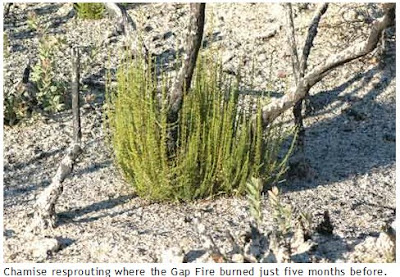...There also is a mistaken feeling that the intense fires of recent years are a product of fire suppression that has allowed the accumulation of large amounts of fuel. This has led to the misconception that homes can be protected by establishing a system of controlled burns to remove accumulated fuel. Yes, we can probably be comforted that the area of the Gap Fire will not burn again in the next couple of years; however, the protection from controlled burns or other means of fuel reduction is short-lived. A brief drive up Highway 154 into the area of the Painted Cave Fire shows dense vegetation that is easily capable of carrying a fire every bit as intense as the fire of 1990. In fact, the regrowth of vegetation in that area was so fast that a new fire could have been carried a mere five years later.
This is not without precedent. Significant portions of the intense 2007 fires in San Diego County occurred in areas that had burned only four years previously. What can we conclude from this? Chaparral carries strong fires regardless of frequency. Since fuel accumulates quickly, fires will burn equally hot whether the vegetation is five years old or 100 years old. The fuel is already there. Chaparral is not a “fire-dependent” ecosystem. It does burn, but it does not “depend” upon fire to be self-sustaining.
There is also evidence that too-frequent burning leads to massive conversion of landscapes from chaparral to a landscape infested with weeds, which are also known to burn with intensity. In San Diego County, the 2003 Cedar Fire burned areas of the 2001 Viejas Fire. Those areas have lost their ability to regenerate native species and now are dominated by invasive annual weeds. These pose an equally dangerous fire problem and a serious ecological problem for land managers. Using controlled burns to reduce fuel accumulation can lead to a pernicious cycle of frequent and continued burning, and may have consequences far beyond those intended.
How To Use Storytelling To Sell Dream Vacations
-
People do not buy trips based on hotel names or flight schedules. They buy
the feeling of escape, connection, and anticipation. Storytelling is one of
th...
2 days ago





No comments:
Post a Comment